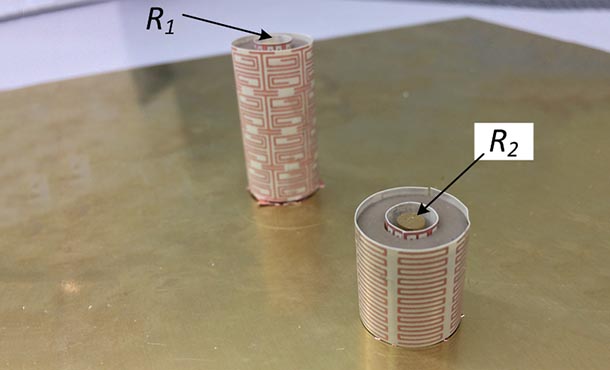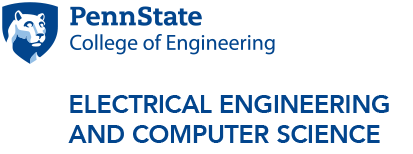
The fabricated metasurface material for antennas, created by Werner and Jiang.
Invisibility cloak aspirations inspire new metasurface material
6/30/2015
UNIVERSITY PARK, Pa. — A fabricated metasurface that leads to improved antenna performance may well represent the first demonstrated practical application for invisibility cloaks, according to Penn State researchers.
Doug Werner, John L. and Genevieve H. McCain Chair Professor of Electrical Engineering, and Zhihao Jiang, postdoctoral scholar in electrical engineering, created a cloaking metasurface for optimal antenna communication. They reported their research in the most recent issue of Advanced Functional Materials.
Their idea is based on the concept of cloaking with quasi-two-dimensional materials engineered to exhibit exotic electromagnetic behaviors.
“To the best of our knowledge, no one knows how to make something invisible by cloaking over a wide frequency band,” said Werner, who directs Penn State’s Computational Electromagnetics and Antennas Research Lab. “But what we could do, with the current state-of-the-art in cloaks for a narrow band of frequencies, is develop special material coatings to put around narrowband antennas that act as cloaks in order to make one antenna invisible to one or more other closely spaced antennas operating at different frequencies. Importantly, the added artificial coating should not affect the functionality of the antenna inside.”
According to Werner, when many antennas are in close proximity to each other, for example on cell phone towers or aboard ships, they can interfere with each other’s performance and are unable to operate at their full capacity. There are two reasons for this: mutual coupling and mutual blockage. Mutual coupling can cause a reduction in the ability of an antenna to efficiently radiate a signal. Mutual blockage occurs when the radiation from one antenna is blocked in a certain direction by the presence of another. While these two phenomena have been a problem for quite some time, there has yet to be an ideal solution to address both issues simultaneously.
“We were able to put these coatings around antennas to isolate or cloak them from other antennas, essentially making them invisible in order to maintain or restore the desired intrinsic radiation properties,” said Werner. “It’s a big advancement in terms of moving cloaking technology closer to practical implementation.”
Testing the antennas, Werner and Jiang were able to tailor the dispersive properties of each metasurface layer and see that the mutual coupling and mutual blockage between multiple antennas each operating at a single or multiple frequencies can be simultaneously reduced.
“Many approaches have been made that only address mutual coupling or mutual blockage, but the solutions are usually not compatible for combining together,” said Jiang. “Here we’ve created a light-weight, low-cost integrated solution capable of mitigating both problems.”



